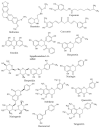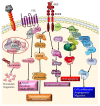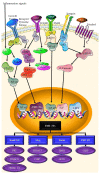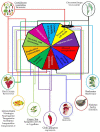Overcoming the Challenges of Phytochemicals in Triple Negative Breast Cancer Therapy: The Path Forward
- PMID: 37375975
- PMCID: PMC10301029
- DOI: 10.3390/plants12122350
Overcoming the Challenges of Phytochemicals in Triple Negative Breast Cancer Therapy: The Path Forward
Abstract
Triple negative breast cancer (TNBC) is a very aggressive subtype of breast cancer that lacks estrogen, progesterone, and HER2 receptor expression. TNBC is thought to be produced by Wnt, Notch, TGF-beta, and VEGF pathway activation, which leads to cell invasion and metastasis. To address this, the use of phytochemicals as a therapeutic option for TNBC has been researched. Plants contain natural compounds known as phytochemicals. Curcumin, resveratrol, and EGCG are phytochemicals that have been found to inhibit the pathways that cause TNBC, but their limited bioavailability and lack of clinical evidence for their use as single therapies pose challenges to the use of these phytochemical therapies. More research is required to better understand the role of phytochemicals in TNBC therapy, or to advance the development of more effective delivery mechanisms for these phytochemicals to the site where they are required. This review will discuss the promise shown by phytochemicals as a treatment option for TNBC.
Keywords: Wnt; angiogenesis; apoptosis; epithelial to mesenchymal transition; metastasis; phytomedicine; tyrosine kinase.
Conflict of interest statement
The authors declare no conflict of interest.
Figures





Similar articles
-
Wnt signaling blockage inhibits cell proliferation and migration, and induces apoptosis in triple-negative breast cancer cells.J Transl Med. 2013 Nov 4;11:280. doi: 10.1186/1479-5876-11-280. J Transl Med. 2013. PMID: 24188694 Free PMC article.
-
Curcumin: Modulator of Key Molecular Signaling Pathways in Hormone-Independent Breast Cancer.Cancers (Basel). 2021 Jul 8;13(14):3427. doi: 10.3390/cancers13143427. Cancers (Basel). 2021. PMID: 34298639 Free PMC article. Review.
-
Low Dose of Paclitaxel Combined with XAV939 Attenuates Metastasis, Angiogenesis and Growth in Breast Cancer by Suppressing Wnt Signaling.Cells. 2019 Aug 14;8(8):892. doi: 10.3390/cells8080892. Cells. 2019. PMID: 31416135 Free PMC article.
-
Targeting Triple-Negative Breast Cancer by the Phytopolyphenol Carnosol: ROS-Dependent Mechanisms.Antioxidants (Basel). 2023 Jun 27;12(7):1349. doi: 10.3390/antiox12071349. Antioxidants (Basel). 2023. PMID: 37507889 Free PMC article. Review.
-
Potential therapeutic targets of triple-negative breast cancer based on its intrinsic subtype.Oncotarget. 2017 Aug 16;8(42):73329-73344. doi: 10.18632/oncotarget.20274. eCollection 2017 Sep 22. Oncotarget. 2017. PMID: 29069872 Free PMC article. Review.
Cited by
-
Harnessing the nutriceutics in early-stage breast cancer: mechanisms, combinational therapy, and drug delivery.J Nanobiotechnology. 2024 Sep 18;22(1):574. doi: 10.1186/s12951-024-02815-8. J Nanobiotechnology. 2024. PMID: 39294665 Free PMC article. Review.
-
Targeting Triple-Negative Breast Cancer: Resistance Mechanisms and Therapeutic Advancements.Cancer Med. 2025 May;14(9):e70803. doi: 10.1002/cam4.70803. Cancer Med. 2025. PMID: 40318146 Free PMC article. Review.
-
Leveraging Cholesterol-Functionalized Cyclodextrin Nanosponges for Enhanced Drug Delivery in Cancer Cells.Int J Mol Sci. 2025 Jan 30;26(3):1213. doi: 10.3390/ijms26031213. Int J Mol Sci. 2025. PMID: 39940979 Free PMC article.
-
Synthesis, Structure, and Stability of Copper(II) Complexes Containing Imidazoline-Phthalazine Ligands with Potential Anticancer Activity.Pharmaceuticals (Basel). 2025 Mar 6;18(3):375. doi: 10.3390/ph18030375. Pharmaceuticals (Basel). 2025. PMID: 40143151 Free PMC article.
-
Fractionation and phytochemical composition of an ethanolic extract of Ziziphus nummularia leaves: antioxidant and anticancerous properties in human triple negative breast cancer cells.Front Pharmacol. 2024 Feb 9;15:1331843. doi: 10.3389/fphar.2024.1331843. eCollection 2024. Front Pharmacol. 2024. PMID: 38405665 Free PMC article.
References
Publication types
Grants and funding
LinkOut - more resources
Full Text Sources
Research Materials
Miscellaneous

